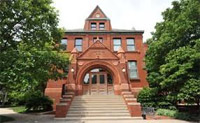Architecture, College of

Masters in Architecture Program: Theses
First Advisor
David Newton
Date of this Version
Spring 5-3-2019
Document Type
Thesis
Citation
Moehlenhoff, Grant. "Blend Space: Architectural Storytelling in the Age of Mixed Reality" Master of Architecture thesis, The University of Nebraska-Lincoln, 2019.
Abstract
Storytelling and narratives have long been traditions for communication in human culture. Hieroglyphics, cave paintings, and stone tablets became the mediums in which this common method of communication began. The reasons why people tell stories are numerous, the most common ones being to entertain, to keep cultural heritage, to transfer knowledge, or provide warnings to others of danger. In addition, cultures often use architecture as a place to embed these narratives.
As technology has rapidly developed, so have the modes for telling stories. Today, stories are moving beyond the physical, and into both virtual and mixed realities. Virtual and augmented reality technologies are receiving more investments as well as becoming more prevalent with the capability to impact society in a number of ways. These technologies are also shaping the way stories are being told and how they are experienced, focusing on the human perspective. While storytelling has been a part of architecture for centuries, the subject of merging mixed reality technology with fundamental architectural elements to convey a narrative remains untapped.
Therefore, this thesis explores the question of how designers can reinvent architecture as a vehicle for storytelling in the age of mixed reality.
It is imperative for the profession of architecture to embrace the powerful possibilities of mixed reality technology as it affords designers the ability to communicate, design, and experience both information and narratives in uniquely humanistic ways by enhancing basic human senses such as sight, sound, and touch. This approach effectively focuses on the user experience which is an often overlooked aspect of design.
Advisor: David Newton


Comments
A thesis Presented to the Architecture Faculty of The College of Architecture at the University of Nebraska In Partial Fulfillment of Requirements For the Degree of Master of Architecture, Major: Architecture, Under the Supervision of Professor David Newton. Lincoln, Nebraska: May, 2019
Copyright (c) 2019 Grant Moehlenhoff